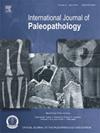Are endocranial granular impressions pathognomonic of tuberculous meningitis or a marker of tuberculous infection? An investigation on a medieval osteoarcheological assemblage from Italy
IF 1.5
3区 地球科学
Q3 PALEONTOLOGY
引用次数: 0
Abstract
Objectives
In recent paleopathological literature, granular impressions on the endocranial surface are considered pathognomonic of tuberculous meningitis. This study aims to verify the presence of granular impressions and assess their relationship with tuberculosis in an archeological human skeletal assemblage.
Materials
The study analyzed the endocranial surfaces of 212 skulls (38 non-adults and 174 adults) from the medieval site of Pieve di Pava, Italy.
Methods
Macroscopic and stereomicroscopic examination of the endocranial surface was conducted to evaluate the presence, location, and manifestation of granular impressions.
Results
Granular impressions affected more than half of the individuals, with no statistical difference between males and females.
Conclusions
The high frequency of granular impressions challenges their interpretation as pathognomonic of tuberculous meningitis, a rare complication of tuberculosis affecting the central nervous system. Instead, these lesions should be considered indicative of bacteremia, when bacilli reach the central nervous system and form tubercles on the meninges. It cannot be established whether these tubercles were quiescent or had ruptured, leading to tuberculous meningitis.
Significance
Based on the pathogenic life cycle of M. tuberculosis, as defined in clinical settings, it seems prudent to consider granular impressions as a marker of tuberculosis infection, rather than of active tuberculosis disease or tuberculous meningitis in paleopathology.
Limitations
Research limitations include the smaller number of non-adults compared to adults.
Suggestions for further research
Screening of granular impressions in other large osteoarcheological assemblages could provide new and more reliable data on the spread of tuberculosis infection across different social contexts, geographical settings, and historical periods.
颅内颗粒状印象是结核性脑膜炎的典型症状还是结核性感染的标志?对意大利中世纪骨考古组合的调查
目的:在最近的古病理学文献中,颅内表面的颗粒状印记被认为是结核性脑膜炎的典型症状。本研究旨在验证颗粒状印痕的存在,并评估其与结核在考古人类骨骼组合的关系。该研究分析了来自意大利Pieve di Pava中世纪遗址的212个头骨(38个非成年人和174个成年人)的颅内表面。方法采用显微和体视镜观察颅内表面颗粒印痕的存在、位置和表现。结果颗粒印象影响了超过一半的个体,在男性和女性之间没有统计学差异。结论高频率的颗粒印痕挑战了其作为结核性脑膜炎的病理特征的解释,结核性脑膜炎是一种罕见的结核影响中枢神经系统的并发症。相反,当杆菌到达中枢神经系统并在脑膜上形成结核时,这些病变应被认为是菌血症的指示。目前还不能确定这些结核是静止的还是破裂的,从而导致结核性脑膜炎。根据结核分枝杆菌的致病生命周期,在临床环境中定义,似乎谨慎考虑颗粒印痕作为结核感染的标志,而不是活动性肺结核或结核性脑膜炎的古病理学。研究的局限性包括与成年人相比,非成年人的数量较少。在其他大型骨考古组合中筛选颗粒印记可以为结核病感染在不同社会背景、地理环境和历史时期的传播提供新的、更可靠的数据。
本文章由计算机程序翻译,如有差异,请以英文原文为准。
求助全文
约1分钟内获得全文
求助全文
来源期刊

International Journal of Paleopathology
PALEONTOLOGY-PATHOLOGY
CiteScore
2.90
自引率
25.00%
发文量
43
期刊介绍:
Paleopathology is the study and application of methods and techniques for investigating diseases and related conditions from skeletal and soft tissue remains. The International Journal of Paleopathology (IJPP) will publish original and significant articles on human and animal (including hominids) disease, based upon the study of physical remains, including osseous, dental, and preserved soft tissues at a range of methodological levels, from direct observation to molecular, chemical, histological and radiographic analysis. Discussion of ways in which these methods can be applied to the reconstruction of health, disease and life histories in the past is central to the discipline, so the journal would also encourage papers covering interpretive and theoretical issues, and those that place the study of disease at the centre of a bioarchaeological or biocultural approach. Papers dealing with historical evidence relating to disease in the past (rather than history of medicine) will also be published. The journal will also accept significant studies that applied previously developed techniques to new materials, setting the research in the context of current debates on past human and animal health.
 求助内容:
求助内容: 应助结果提醒方式:
应助结果提醒方式:


